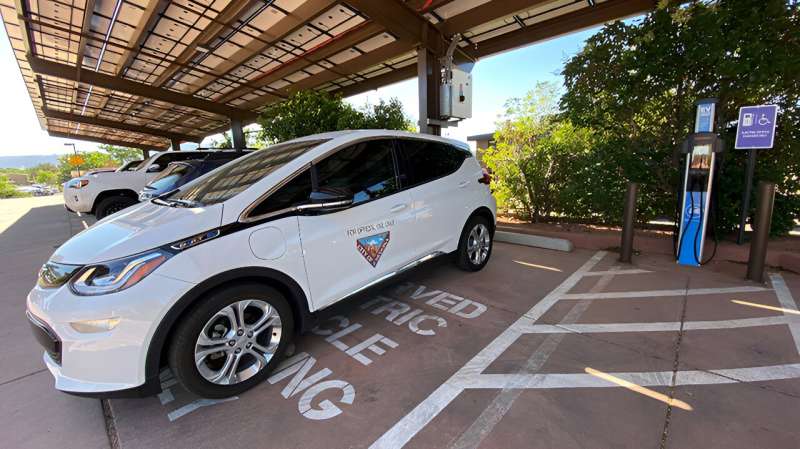This article has been reviewed according to Science X's editorial process and policies. Editors have highlighted the following attributes while ensuring the content's credibility:
fact-checked
trusted source
proofread
Electric vehicles grow in the desert: Peer learning helps Sedona plan for charging infrastructure

The desert city of Sedona, Arizona, is home to less than 10,000 people but welcomes nearly 3 million visitors every year. The city knows it needs a big boost to its electric vehicle (EV) charging infrastructure to support greater numbers of tourists rolling in on EVs and to support municipal fleet electrification.
Seeking ways to build EV charging capacity, Sedona participated in a peer-learning cohort through the U.S. Department of Energy's (DOE's) Clean Energy to Communities (C2C) program focused on planning and funding strategies for EV charging infrastructure deployment. Interactions with peers and tailored advice from experts provided the city with valuable tools and ideas for updating their building codes to streamline the process for installing EV chargers.
"We were just excited to see what that path could look like," said Bryce Beck, Sedona's sustainability manager, who participated in the C2C cohort. "We were trying to get a sense of available funding opportunities along with the strategies we could utilize to align city codes more effectively to meet electrification and climate action goals."
Tourism is not the only reason Sedona needs more robust charging infrastructure. The city's Climate Action Plan, adopted in 2021, set a goal to cut Sedona's greenhouse gas emissions by 50% by 2030. That plan includes transitioning all passenger vehicles in the city-operated fleet to zero-emissions vehicles.
"We've had a number of chargers installed over the last few years, but the program is relatively small in scale because we are also a very rural community," Beck said.
With many questions about how to expand their installation efforts, Sedona joined 14 other organizations in this C2C cohort, meeting regularly from July to December in 2023. C2C cohorts are funded by DOE and managed by the National Renewable Energy Laboratory (NREL) with support from the World Resources Institute.
Each cohort is made up of 10–15 representatives from local and regional governments, Tribes, electric utilities, or community-based organizations. Participants learn from each other and national laboratory experts in a collaborative environment centered on a clean energy topic.
Sedona's participation in the cohort gave the city new ideas about how to update its code to support EV infrastructure needs. One-on-one technical assistance with experts helped facilitate deeper discussion of potential updates for their municipal codes and provided guidance for implementing Sedona's current EV building code, which requires 5% EV-capable parking spaces at new commercial developments.
NREL helped Sedona consider safety needs for EV infrastructure and envision how to incorporate flexibility into its building code, allowing developments to have slower or faster charging speeds based on the type of property. For example, a fast-food restaurant, where customers only stay for a very short time, would likely want to have faster charging speeds than a hotel, where customers stay overnight.
Experts also provided Sedona with access to valuable resources, like an EV code strategy document containing examples of existing codes across the country, many of which could potentially be adapted to Sedona as well. Resources and activities created for the cohort are available for anyone to use through the Joint Office of Energy and Transportation's Public EV Infrastructure Playbook.
Beck emphasized how networking was beneficial throughout the cohort, which provided perspectives from communities of all sizes. C2C also put him in contact with Arizona's Clean Cities and Communities coalition, known as Valley of the Sun Clean Cities, expanding his network of connections across the state and beyond.
"It gave me hope," Beck said. "It's oftentimes that we are in a position where we are trying to change systems that have been the same for decades. It gives me inspiration that there are folks all over the place trying to make this happen, from small coalitions to cities to counties to states."
Pam Adams, sustainability planner for the Center Region Council of Governments in Pennsylvania who also participated in the cohort, saw her connections grow because of the cohort, too.
"I would hear things and think, that's the same thing I'm going through," Adams said. "Now I feel like I could call or email folks in Maine or Milwaukee, and that's super valuable."
By the cohort's conclusion, Beck felt more confident to tackle Sedona's EV infrastructure goals and move toward developing additional charging infrastructure. Sedona plans to incorporate learnings from the cohort as it considers municipal code updates, expands local resources like an EV charging map and a document answering frequently asked questions about EVs, and builds out a decarbonization road map.
"The resources and the educational information we gathered from these cohorts will be directly incorporated into projects to make EV infrastructure more visible and encourage more EV adoption," Beck said. "I think as EVs become more visible … you're building momentum to show people it's not an abstract thing that only Chicago or Phoenix are doing. A small town like Sedona is getting EV infrastructure, they have EVs, and it's available."


















